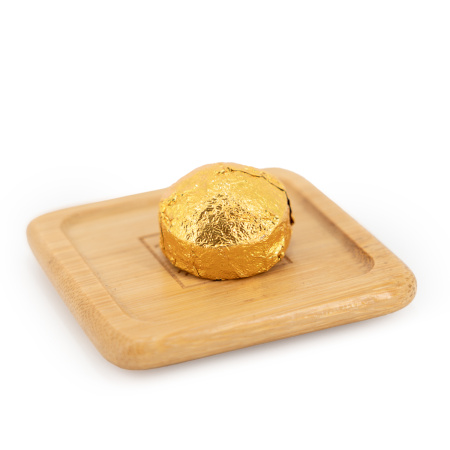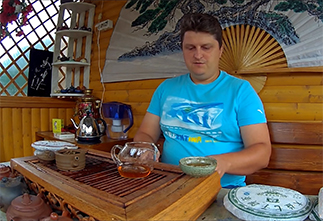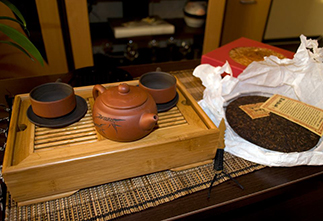-
0 Saturation
-
0 Aftertaste
-
0 Aroma
-
0 Effect
-
0 Balance
-
0 Body
Шу пуэр мини точа от Кайшуньхао: плотность и удобство в каждой чашке
В быстром ритме современной жизни удобство часто выходит на первый план, даже в таком медитативном занятии, как чаепитие. Шу пуэр мини точа (熟普洱迷你沱茶, Shú pǔ'ěr mínǐ tuóchá) от завода Кайшуньхао (开顺号, Kāi shùn hào) идеально отвечает этому запросу, предлагая классический вкус шу пуэра из провинции Юньнань в исключительно удобном формате однопорционных "гнездышек". Фабрика Кайшуньхао представляет этот популярный формат пуэра, ориентируясь на любителей чая, ценящих простоту и стабильное качество для ежедневного употребления.
Шу пуэр из Юньнани (ферментация в кучах)
Основа этого чая – классический шу пуэр. Он производится в провинции Юньнань с использованием технологии ускоренной ферментации во влажных кучах ("водуй" - 渥堆). Этот процесс придает чаю характерные свойства:
- Темный, насыщенный цвет настоя.
- Мягкий, гладкий вкус без горечи и терпкости.
- Глубокий аромат с типичными древесными, ореховыми, землистыми или сладковатыми нотами.
Формат мини точа (5 грамм): удобство превыше всего
Главная особенность этого продукта – форма прессовки мини точа (迷你沱茶,Mínǐ tuóchá). Чай спрессован в маленькие порционные "гнезда" или "чаши", каждое весом около 5 грамм. Это невероятно удобно:
- Не нужно ломать: Нет необходимости использовать нож или шило, как для больших блинов или кирпичей.
- Идеальная порция: 5 грамм – оптимальное количество для одного заваривания в гайвани, кружке или небольшом чайнике.
- Портативность: Легко взять несколько штук с собой на работу, в поездку или на природу.
Вкус и аромат: плотный и базовый
При производстве этого чая был сделан максимальный упор "на плотность". Вкус абсолютно базовый, но очень плотный классический вкус шу. От этого мини точа не стоит ожидать сложных, многогранных переливов, но можно рассчитывать на насыщенный, густой, типично "пуэрный" вкус: долго пьющийся шу с приятными древесно-землистыми тонами и легким кедрово-ореховым оттенком.
Стойкость в заваривании
У данного экземпляра хорошая стойкость чая к проливам. Даже после 5 пролива он все еще остается довольно бодрым. Это говорит о хорошем качестве сырья и прессовки, позволяющих получить достаточно долгую чайную сессию.
Целевая аудитория и ценность
Эти мини точа идеально подходят для тех, кто ищет надежный, плотный классический шу пуэр на каждый день, чтобы взбодриться без лишних изысков. Приятная цена также подчеркивает их привлекательность в качестве повседневного чая с хорошим соотношением цены и качества.
Рекомендации по завариванию
Заваривание предельно простое:
- Возьмите одну мини точу (5 грамм).
- Поместите ее в прогретую гайвань, чайник или кружку (объемом ~100-180 мл).
- Промывка: Залейте кипятком (95-100°C) и сразу слейте воду. Рекомендуется повторить промывку 1-2 раза, чтобы гнездышко лучше раскрылось.
- Заваривание: Заваривайте проливами, начиная с 10-15 секунд и постепенно увеличивая время настаивания. Чай выдерживает достаточно много проливов.
- Опция: Для более насыщенного и долгого чаепития можно использовать две мини точи (10 г).
Шу пуэр мини точа от кайшуньхао – это превосходный пример того, как удобство формата сочетается с достойным качеством и честным вкусом. Плотный, базовый профиль с орехово-древесными нотами, хорошая стойкость к проливам и максимальная простота в использовании делают этот чай отличным выбором для ежедневных чаепитий дома, в офисе или в дороге. Это надежный и доступный способ насладиться классическим шу пуэром.
|
Country
|
China |
|
Provinces
|
Yunnan (云南) |
|
Manufacturer
|
Кайшуньхао (开顺号) |
|
Fermentation method
|
In heaps |
- Reviews
- Vkontakte
The question often arises: how to brew puerh correctly? Sometimes the phrase "to get high" is added to it. Moreover, everyone has their own understanding of this phrase. Some mean vigor, and some - intoxication. So how to brew puerh tea correctly? Let's consider several options.
Traveling through the tea mountains, we found ourselves in another land of blue roofs - the village of Zhongcai, which is located in the Menghai district of Yunnan province. According to tradition, we were shown another local tea tree, which, according to the Chinese, is at least a million years old :) The village is very authentic, not designed for tourists, there are many wild pu-erhs there and, of course, we were warmly received. They treated us to local cuisine and tea. We also asked the residents about the prices of tea and how they have changed in recent years.
The tea ceremony occupies a special place in the centuries-old Eastern tradition. And although the essence of this phenomenon remains constant, the nature and external manifestations of the tea ceremony in different nations have their own national characteristics. In each Chinese province, the tea ceremony and the tea used in it are varied: for example, residents of the southern provinces prefer green tea, and residents of the northern provinces - red tea, in Fujian province they more often use Oolong tea, and in Yunnan province Puer tea is widely known.






















































































